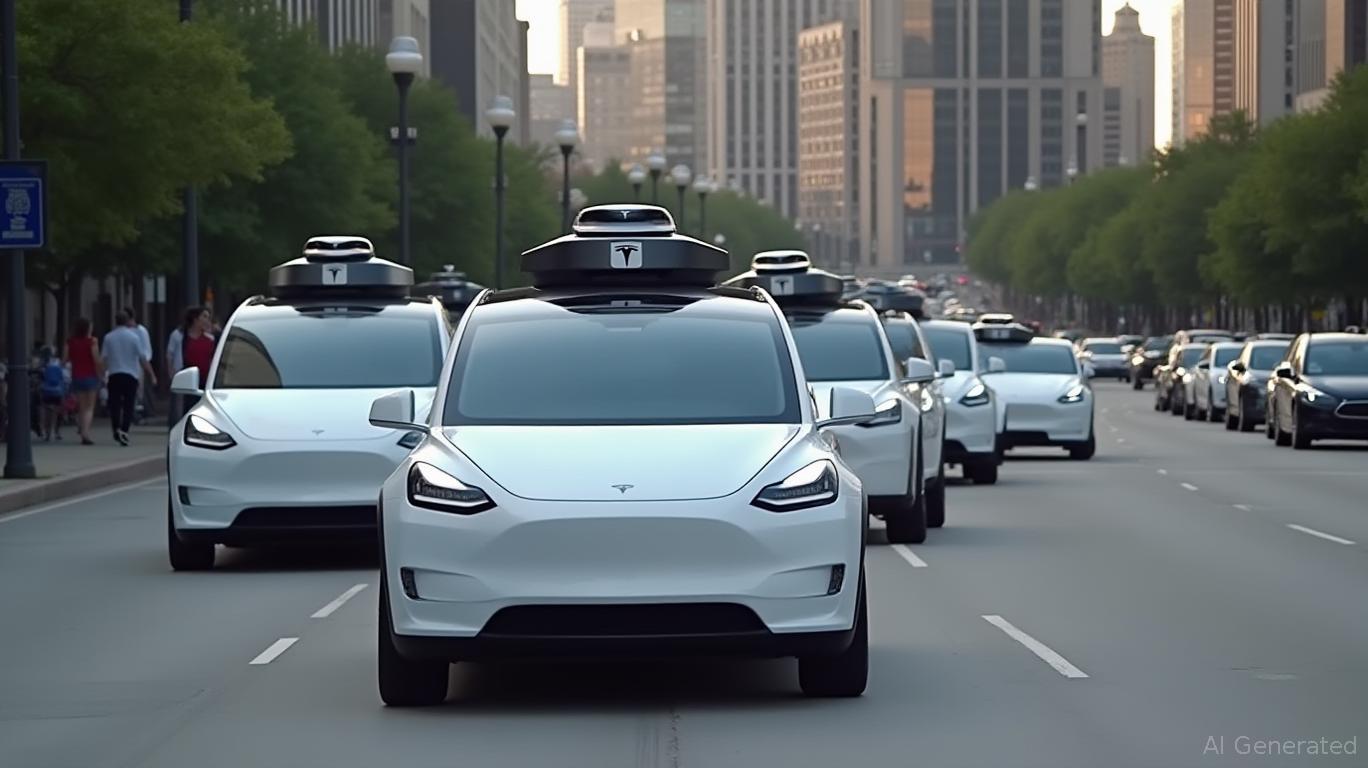Tesla's Robotaxi Launch: Navigating Risk and Reward Amid a Volatile Landscape
The long-awaited
Robotaxi launch, set for June 12, 2025, marks a pivotal moment for the company's vision of autonomous mobility. However, this milestone arrives amid a backdrop of macroeconomic pressures, regulatory uncertainty, and the tempestuous Trump-Musk feud. For investors, the question is clear: Does the promise of Tesla's autonomous future outweigh the risks of execution failures, political volatility, and valuation skepticism? This article dissects the strategic implications and outlines a path for investors to navigate this high-stakes environment.
The Robotaxi Launch: A Make-or-Break Milestone
Tesla's Robotaxi service—initially deploying 10 Model Y vehicles in Austin—represents the first public trial of its Full Self-Driving (FSD) Unsupervised software. Success here could validate Tesla's leadership in autonomous driving, a domain where competitors like Waymo and Cruise have yet to achieve mass deployment. A smooth rollout would likely boost investor confidence in Tesla's ability to monetize its software prowess, potentially unlocking a $200 billion autonomous mobility market by 2030. However, the stakes are high: delays or safety incidents could dent the company's credibility and erode its valuation premium.
The Trump-Musk Feud: A Catalyst for Volatility
The feud between Elon Musk and President Trump has already roiled Tesla's stock, with shares plunging 14% in late May before a partial recovery. At its core, the conflict reflects a clash of visions: Musk's advocacy for tech-driven deregulation versus Trump's populist fiscal agenda. The immediate risks include:- Regulatory Rollbacks: The Trump administration could retaliate by scaling back subsidies for Tesla's EVs or imposing stricter oversight on its autonomous software.- Contract Cancellations: Over $2 billion in government contracts tied to SpaceX and Tesla's energy division remain at risk if tensions escalate.- Consumer Sentiment: Musk's controversial political stances—such as endorsing far-right groups—could alienate conservative consumers, exacerbating Tesla's recent sales declines in key markets.
The feud also underscores a broader theme: Tesla's success hinges on its ability to navigate political and regulatory landscapes as deftly as its technology. While the White House has yet to take concrete punitive action, the mere threat of intervention has amplified market volatility.
Valuation Sensitivity: Between Optimism and Overhang
Tesla's valuation—currently trading at ~$300 billion—assumes flawless execution of its ambitious roadmap. Key metrics to watch include:- Robotaxi Adoption: Will the service scale to thousands of vehicles by year-end, or will safety concerns and regulatory hurdles slow progress?- FSD Profitability: Can Tesla monetize its software through subscription models or partnerships, or will it remain a costly R&D endeavor?- Competitor Dynamics: How will Chinese EV giants like BYD and XPeng respond to Tesla's autonomous push?
Near-Term Risks vs. Long-Term Dominance
Near-Term Risks:- Regulatory Hurdles: State-level pushback (e.g., California's emissions standards) or federal scrutiny of Tesla's FSD could delay Robotaxi expansion.- Execution Gaps: Tesla's history of missing production targets (e.g., Cybertruck recalls, Milan Kovac's robotics division departure) raises concerns about its ability to scale autonomously driven fleets reliably.- Macroeconomic Pressures: Rising interest rates and a potential recession could dampen demand for premium EVs, squeezing Tesla's margins.
Long-Term Opportunities:- Market Leadership: Tesla's first-mover advantage in autonomous vehicles could cement its position as the go-to partner for tech companies (e.g., Apple, Amazon) seeking mobility solutions.- Software as a Service (SaaS): A successful Robotaxi network could transform Tesla into a SaaS powerhouse, generating recurring revenue from FSD upgrades and data monetization.- Global Expansion: Texas is just the beginning; Tesla's mule sightings in Boston and New Hampshire suggest aggressive geographic scaling.
Investment Considerations: Balancing Fervor and Caution
Buy Zones: - Support Levels: Institutional buyers may step in at $200–$220 per share, where Tesla's price-to-sales ratio becomes more aligned with its peers.- Catalysts: Positive Robotaxi trial data, FSD software updates, or geopolitical detente with the Trump administration could spark rallies.
Retail vs. Institutional Sentiment:- Retail Investors: Fervent Musk supporters remain undeterred by volatility, betting on his "master plan" for autonomous dominance. This group may dominate short-term price swings.- Institutions: Pension funds and hedge funds are likely to remain on the sidelines until Tesla proves its autonomous tech's reliability and profitability. They may only commit capital once Robotaxi adoption rates and regulatory clarity improve.
Risk-Adjusted Strategy:- Aggressive Investors: Allocate 5–10% of a portfolio to Tesla stock at $220, with stop-losses at $200, targeting $250–$280 if the Robotaxi launch succeeds.- Conservative Investors: Focus on Tesla's ecosystem plays (e.g., battery suppliers like CATL, software partners like NVIDIA) to capture upside without bearing equity risk.
Conclusion
Tesla's Robotaxi launch is a defining moment for its autonomous future—but it is not without peril. The stock's risk-reward balance hinges on execution, regulatory grace, and the resolution of the Trump-Musk feud. For bulls, the long-term vision of a $1 trillion mobility empire remains compelling. For bears, near-term execution risks and valuation overhangs loom large. Investors must decide: Is Tesla's autonomous ambition worth the ride, or is this a high-speed crash waiting to happen?

Comments
No comments yet